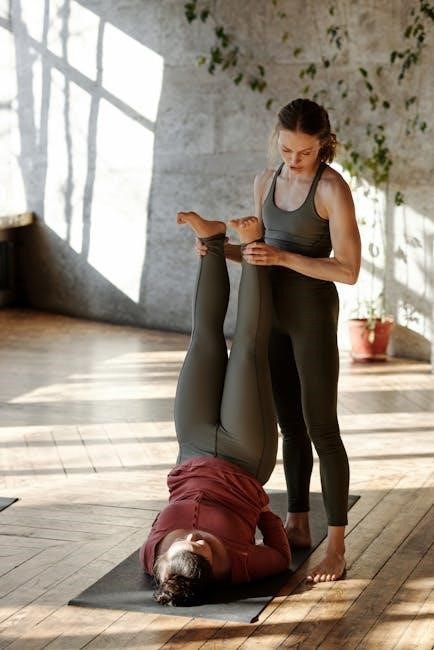A full-body workout is a comprehensive training approach targeting all major muscle groups in a single session, enhancing strength, endurance, and flexibility while optimizing time and efficiency․
1․1 Benefits of Full-Body Workouts
Full-body workouts offer numerous benefits, including improved cardiovascular health, increased muscle strength, and enhanced flexibility․ They are time-efficient, targeting multiple muscle groups simultaneously, which accelerates progress and boosts metabolism․ Regular full-body training also improves coordination, balance, and overall physical fitness․ Additionally, these workouts support weight management and can be adapted to various fitness levels, making them ideal for both beginners and experienced individuals․
1․2 Key Components of a Full-Body Workout
A full-body workout typically includes compound exercises like squats, deadlifts, and bench presses, targeting multiple muscle groups․ It incorporates a mix of upper and lower body movements, core exercises, and functional training․ The routine often involves free weights, resistance bands, or bodyweight exercises, ensuring comprehensive muscle engagement․ Proper form, progression, and a balanced approach are essential for effectiveness and safety․

Top Exercises for a Full-Body Routine
Effective full-body workouts include exercises like squats, push-ups, pull-ups, and deadlifts․ These compound movements target multiple muscle groups, improving strength and efficiency in each session․
2․1 Squats and Lunges
Squats and lunges are fundamental compound movements targeting the legs, glutes, and core․ Squats build strength in the quadriceps and hamstrings, while lunges improve balance and unilateral strength․ Variations like bodyweight, barbell, or dumbbell options cater to different fitness levels, making them versatile for full-body routines․ Incorporating these exercises enhances overall lower body development and functional mobility․
2․2 Push and Pull Exercises
Push exercises, such as bench presses and overhead presses, target the chest, shoulders, and triceps, while pull exercises like pull-ups and rows focus on the back and biceps․ These movements enhance upper body strength, improve posture, and promote muscle balance․ They are essential for a well-rounded physique and can be performed with dumbbells, resistance bands, or machines for variety and progression․
2․3 Core and Functional Movements
Core exercises like planks, bird dogs, and Russian twists strengthen the abdominals and improve stability․ Functional movements, such as overhead presses and rotational exercises, enhance coordination and real-world mobility․ These exercises promote better posture, reduce injury risk, and improve overall athleticism, making them integral to a balanced full-body workout routine for long-term fitness and daily functionality․
Sample Full-Body Workout Plans
Discover versatile workout plans, including 3-day, 4-day, and home options, designed to suit various schedules and fitness goals, ensuring efficiency and comprehensive muscle engagement for all levels․
3․1 3-Day Full-Body Split
A 3-day full-body split involves training on alternating days, with cardio or rest in between․ Each session includes 6-10 exercises targeting major muscle groups like legs, chest, and back․ This approach balances muscle engagement, enhances metabolism, and fits busy schedules․ Equipment options range from dumbbells to bodyweight exercises, ensuring versatility for all fitness levels and goals․
3․2 4-Day Full-Body Split
A 4-day full-body split allows for increased intensity and recovery time․ It typically includes three training sessions and one active recovery or cardio day․ This plan is ideal for those seeking progressive overload and muscle balance, with exercises tailored to individual goals․ Equipment options like dumbbells and kettlebells add variety, making it adaptable for home or gym workouts․
3․3 Home Workout Options
Home workouts are convenient and effective, requiring minimal equipment․ Bodyweight exercises, resistance bands, and dumbbells are great tools․ Plans often include circuit training or HIIT for efficiency․ Follow structured routines with warm-ups, full-body exercises, and cool-downs․ Many guides offer meal planning and progression tips, ensuring balanced fitness without gym access․ Ideal for busy schedules and home-based fitness enthusiasts․

Incorporating Cardio and Core Training
Incorporating cardio and core training enhances overall fitness, improves heart health, and boosts metabolism․ Combine HIIT, steady-state cardio, and exercises like planks, Russian twists, and leg raises for a balanced routine․
4․1 Cardio Exercises to Enhance Fat Loss
Cardio exercises like HIIT, running, cycling, and swimming are effective for fat loss․ They boost metabolism, burn calories, and improve heart health․ Incorporate interval training for maximum results, as it accelerates fat burning and enhances endurance․ Consistency and intensity are key to achieving significant fat loss through cardio workouts․
4․2 Core-Strengthening Routines
Core-strengthening routines focus on exercises like planks, crunches, Russian twists, and leg raises․ These movements improve posture, balance, and overall stability․ Aim to perform core workouts 3-4 times weekly, dedicating 15-20 minutes per session․ Incorporating these exercises into your daily routine enhances athletic performance and supports full-body workouts effectively․

Popular Fitness Programs and Guides
Popular fitness programs like Kayla Itsines’ Bikini Body Guide and Anna Victoria’s Fit Body Guides offer structured workouts, meal plans, and motivation for achieving fitness goals efficiently․
5․1 Kayla Itsines’ Bikini Body Guide
Kayla Itsines’ Bikini Body Guide is a 12-week fitness program designed for women, focusing on resistance training, cardio, and nutrition․ It includes 3 resistance sessions, 3 cardio days, and 2 recovery days weekly, with a downloadable nutrition manual․ The guide emphasizes whole-body strength, toning, and sustainability, making it suitable for all fitness levels․
5․2 Anna Victoria’s Fit Body Guides
Anna Victoria’s Fit Body Guides offer structured daily workouts and meal plans, focusing on strength, toning, and overall well-being․ Designed for all fitness levels, the program emphasizes balanced nutrition and sustainable results․ It allows flexibility, enabling users to enjoy life while achieving their goals through a combination of effective exercises and mindful eating habits․

Equipment and Tools for Full-Body Workouts
Dumbbells, kettlebells, medicine balls, and resistance bands are essential for full-body workouts, offering versatility and effectiveness in targeting all major muscle groups efficiently and safely․
6․1 Dumbbells and Kettlebells
Dumbbells and kettlebells are versatile tools for full-body workouts, offering portability and effectiveness․ They enable compound movements like squats, presses, and swings, targeting multiple muscle groups simultaneously․ Ideal for building strength and endurance, these tools are suitable for both beginners and advanced fitness enthusiasts, providing scalable resistance to match any fitness level․
6․2 Medicine Balls and Resistance Bands
Medicine balls and resistance bands are essential tools for functional training, improving core strength, and boosting flexibility․ Medicine balls enhance dynamic movements like slams and tosses, while resistance bands provide tension for exercises like banded squats and chest presses․ Both are portable, cost-effective, and ideal for home workouts, offering versatile resistance to target multiple muscle groups effectively․

Nutrition and Recovery
Nutrition and recovery are crucial for muscle growth and overall health․ Proper meal planning ensures adequate protein, carbs, and hydration, while recovery techniques like sleep and stretching prevent injury․
7․1 Meal Planning for Optimal Results
Meal planning is essential for achieving fitness goals, ensuring a balanced intake of protein, healthy fats, and complex carbs․ Proper hydration and portion control are key․ Experts like Kayla Itsines emphasize structured meal plans to fuel workouts and recovery, promoting sustainable weight loss and muscle toning․ Consistency in nutrition supports metabolism and muscle repair, aligning with the body guide principles․
7․2 Importance of Hydration
Hydration is vital for physical performance and recovery, as water transports nutrients and oxygen to cells․ Even mild dehydration can cause fatigue and impair workout efficiency․ Aim for 8-10 glasses daily, adjusting for activity levels․ Monitor urine color and listen to your body’s thirst cues․ Proper hydration supports muscle function, digestion, and overall health, enhancing your fitness journey and body guide goals․

Progression and Variation in Workouts
Progression and variation are key to avoiding plateaus․ Gradually increase intensity, modify exercises, or change routines to keep workouts challenging and effective, ensuring continuous improvement and engagement․
8․1 Increasing Intensity Over Time
Incorporate progressive overload by adding weight, reps, or sets over time․ Vary exercises or intensity techniques like circuit training or interval workouts to challenge muscles differently․ Gradually increase resistance or reduce rest periods to elevate difficulty, ensuring continued progress and avoiding plateaus․ Consistency and strategic adjustments are key to long-term success and improved physical performance․
8․2 Modifying Exercises for Different Fitness Levels
Modify exercises to suit individual fitness levels by adjusting weights, reps, or resistance․ Beginners can start with bodyweight movements, while advanced individuals can add resistance using dumbbells or bands․ Incorporate variations like incline push-ups for less intensity or deficit push-ups for more challenge․ Tailor workouts to ensure accessibility and effectiveness for all fitness levels, promoting progress and engagement․

Common Mistakes to Avoid
Overtraining, poor form, and neglecting warm-ups are common mistakes that can lead to injury or hinder progress in a full-body workout routine․
9․1 Overtraining and Recovery
Overtraining is a common mistake that can lead to injuries, fatigue, and stalled progress․ Ensuring adequate recovery through rest, stretching, and hydration is crucial for muscle repair and growth․ Ignoring recovery can result in overuse injuries and burnout, undermining workout consistency and effectiveness․ Balancing intensity with recovery is essential for sustainable fitness progress and overall well-being․
9․2 Proper Form and Technique
Maintaining proper form and technique is vital for maximizing workout effectiveness and preventing injuries․ Incorrect movements can strain muscles or joints, leading to discomfort or long-term damage․ Focus on engaging the correct muscle groups and avoiding shortcuts․ Utilize mirrors, trainers, or videos to ensure accuracy․ Consistent attention to form enhances results and promotes sustainable progress in fitness routines․

Staying Motivated and Consistent
Consistency is key to achieving fitness goals․ Set realistic targets, track progress, and celebrate small victories to stay motivated․ Surround yourself with supportive communities and reminders to maintain dedication and enthusiasm for your workout routine․
10․1 Setting Realistic Goals
Setting realistic goals is essential for long-term success․ Define specific, measurable objectives aligned with your health and fitness level․ Break larger goals into smaller, achievable milestones․ Consider your lifestyle, schedule, and preferences when creating a plan․ Programs like Kayla Itsines’ Bikini Body Guide and Anna Victoria’s Fit Body Guides emphasize setting attainable targets․ Celebrate progress, no matter how small, to stay motivated and committed to your journey․
10․2 Tracking Progress
Tracking progress is vital to staying motivated and ensuring your fitness journey is on course․ Use tools like workout journals, fitness apps, or progress photos to monitor improvements․ Celebrate small milestones to maintain enthusiasm․ Adjust your goals and plans as needed to reflect your advancements․ Regular tracking helps identify areas for growth and keeps you accountable․
Full-body workouts are a powerful way to build strength and fitness efficiently; Stay consistent, track progress, and explore resources for continued growth and success in your journey․
11․1 Final Tips for Success
Stay consistent, track progress, and listen to your body․ Maintain a positive mindset and celebrate small victories․ Set realistic goals and explore resources for continued learning․ Surround yourself with support and stay motivated to achieve long-term success in your fitness journey․
11․2 Resources for Further Learning
Explore fitness apps like MuscleWiki and Sweat for detailed exercise libraries․ Follow expert guides from Kayla Itsines and Anna Victoria for structured plans․ Visit websites like Gymbeam and Pinterest for inspiration and tutorials․ Engage with fitness communities on platforms like Reddit and YouTube for tips, motivation, and personalized advice to enhance your fitness journey․